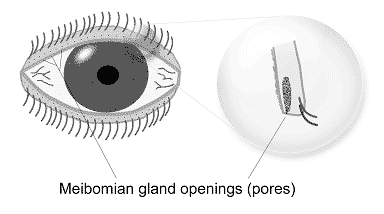Doxycycline Use in Cornea and External Disease
Ayad A. Farjo, MD
Common uses for Doxycycline (or Tetracycline or Minocycline) include the following eye diseases
- Blepharitis
- Ocular Rosacea
- Corneal inflammatory diseases
- Corneal infections
How does it work?
The medication is used for several reasons that are not related to its normal use as an antibiotic:

- By concentrating in the Meibomian glands (lipid- or oil-forming glands at the edge of each eyelid), a more stable tear film is achieved. This can improve sensations of scratchiness and dryness.
- Altering the lipid with doxycycline may reduce free fatty acid formation by bacteria on the eyelids. Free fatty acids are similar to household detergents and may cause a burning sensation of the eye.
- Doxycycline blocks or inhibits some of the body's responses to infection and inflammation. Inflammation makes the eye and eyelids red and irritated. By reducing excessive inflammation, delicate tissues such as the cornea may be spared from scarring and / or destruction.
How often do I take it?
Doxycycline is usually started at 100 milligrams twice daily and gradually reduced or stopped over time. It can and should be taken with morning and evening meals. Tetracycline and Minocycline should not be taken with dairy products.
Are there any side effects?
As with all medicines, serious side effects are possible. The most common side effects with doxycycline are upset stomach and increased sensitivity to sunlight (possibly leading to sunburn). Less frequently, skin rashes and hypersensitivity reactions have been reported so if you experience any unusual symptoms while on this medication, you should notify your physician promptly.
Who shouldn’t take this medicine?
Doxycycline should not be used in the last half of pregnancy, infants, and children under the age of 8 because it may cause permanent discoloration of the teeth (yellow, gray, and brown). Nursing mothers should not take doxycycline as it may be transmitted to the infant in human milk. The safety of doxycycline in early pregnancy has not been established and should therefore not be used. It may also interact with other medications, including oral contraceptives (making them less effective) and methotrexate (making it have an effectively higher dose).
What else can I do to improve the oily layer of the tear film?
 Your
physician may also instruct you to perform warm, moist compresses
one to four times per day to increase the flow of oil from the meibomian
glands. These compresses are typically used up to ten minutes at
a time, with care taken not to burn the skin. The meibomian glands
open on the edge of each eyelid through about 30 orifices (pores).
Warm compresses help open the clogged pores. Your physician may
also recommend gentle brushing at the edge of the eyelid (lid scrubs)
to help loosen debris that may be blocking the pores.
Your
physician may also instruct you to perform warm, moist compresses
one to four times per day to increase the flow of oil from the meibomian
glands. These compresses are typically used up to ten minutes at
a time, with care taken not to burn the skin. The meibomian glands
open on the edge of each eyelid through about 30 orifices (pores).
Warm compresses help open the clogged pores. Your physician may
also recommend gentle brushing at the edge of the eyelid (lid scrubs)
to help loosen debris that may be blocking the pores.


